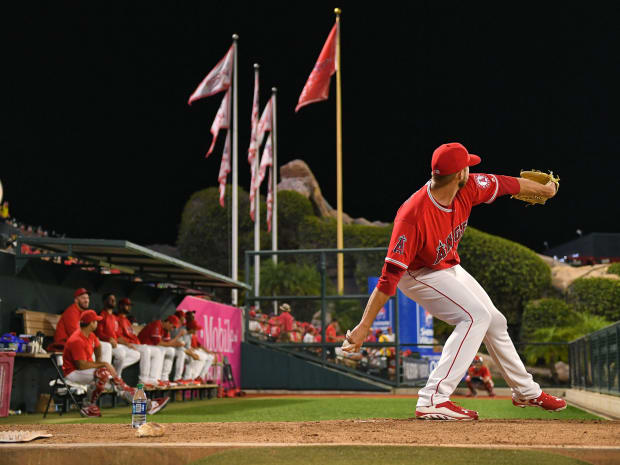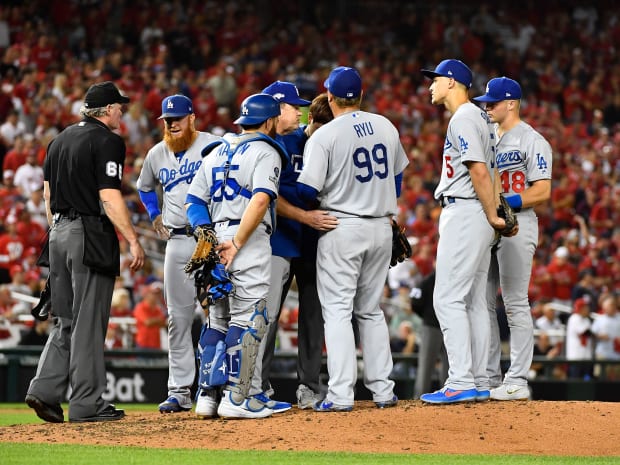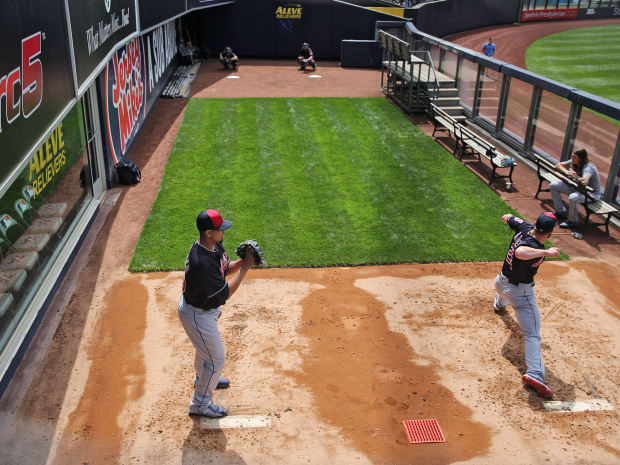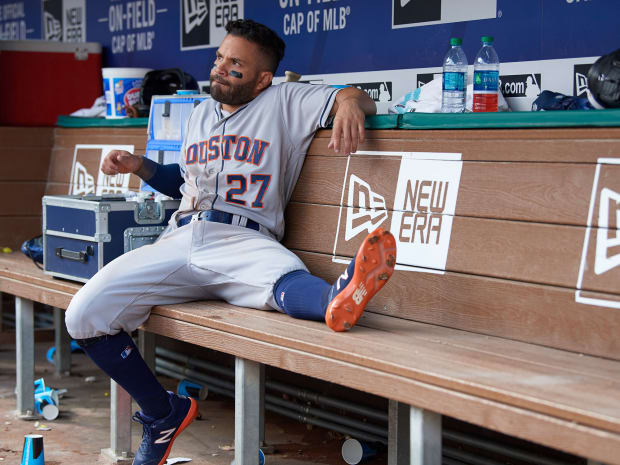Baseball will undoubtedly look different than it ever has before this season.
Major league players and owners did not come to an agreement. It’s more like a ceasefire.
Both sides knew they couldn’t keep fighting a war of attrition, so MLB imposed a 60-game regular season for 2020 with a regular-sized postseason field. The players association consented to the health and safety protocols on Tuesday and said players will report to training camps by July 1.
If anything, the only thing the two sides agreed upon since their March 26 agreement was that they had too many disagreements to come to a compromise. It’s sad.
But, we’ll still have baseball this year. Hopefully. That can’t be certain during a pandemic. Proceed with caution, baseball fans, and we’ll see where we are in a month.
If the national pastime does get underway this year, though, what is it going to look like? After flipping through the official document outlining the league’s new procedures and protocols, we’ve got some answers, and a lot of questions. Here are 13 of them:
1. How is this going to work?
Everyone working in MLB must adhere to all 101 pages of the 2020 MLB Operations Manual, outlining the health and safety protocols, on- and off-field rules, travel regulations and league operations put in place for this season.
Much like the U.S. Constitution, this is an experiment with language included specifically so it can be amended. “As comprehensive as this manual is,” the document reads in the introduction, “it does not address every aspect of MLB and Club operations for the 2020 season. Additional guidance may be provided throughout the season.”
In other words, the league reserves the right to make changes to the format and procedures for the season as things change. With an ever-evolving virus continuing to spread, unforeseen obstacles will emerge. How the league tries to solve these problems, and how the players react to those solutions, will decide the fate of the 2020 season.

2. Will there be social distancing?
Yes, when it is practical.
For active players, coaches and umpires, they are not required to maintain social distancing when they are on the field. In these situations they do not have to wear masks. Players do not have to wear masks in the dugouts, bullpens or on the field.
When possible in the dugouts or bullpens, players should maintain a distance of six feet from one another. Only players on the active roster who are likely to enter the game are allowed in the dugout. Starting pitchers who are not scheduled to pitch that day, as well as inactive players, can sit in the stands as long as they are are at least six feet away from another person.
If players or coaches want to lean on part of the dugout, they need to do so with a “clean towel as a barrier between themselves and the railing or ledge.”
Players sitting in the stands or elsewhere to social distance are expected to adhere to the same conduct as they would if they were in the dugouts or bullpens. That means no cellphones or illegal electronic devices.
Individual lockers need to have six feet of separation from the others (which they don't come close to having in a regular locker room), and if that isn’t possible then temporary space should be built to accommodate additional lockers.
3. What about mound visits?
Ah, the good ole mound visit, when catchers and infielders and coaches consult the pitcher on the mound, gloves covering mouths while standing less than six feet apart. These strategic conversations will be hard to do from a safe distance. In empty ballparks, it will be easier for opponents to eavesdrop.
This isn’t addressed in any of the 101 pages of the manual. Maybe pitchers will have to fend for themselves. Maybe he’ll wear an earpiece so the manager or pitching coach can talk to him from the dugout. Or maybe there won't be any change at all.
4. Don’t go crazy, folks?
No high-fives, fist bumps, hand shakes or hugs allowed. No dog piles at home after walk-offs.
Win the pennant? Congratulate your teammates back at home with a champagne celebration over Zoom.
5. What’s this I’m hearing about a wet rag?
Baseball is gross. Sure, the parameters of the game are more conducive to social distancing than football or basketball, but unsanitary habits are entrenched in the sport.
Think of a cartoon caricature of a big leaguer. A large, sweaty man who spits on his hands before gripping a bat, steps to the plate with a wad of tobacco in his cheek. He hocks a loogie before and after every pitch, adjusts his cup, wipes the sweat off his face and even blows a snot rocket or two. The pitcher is an even larger, sweatier man who rubs the communal rosin bag, touches the pine tar conspicuously coated on the back of his neck and licks his fingers before pulling his glove near his open mouth.

That leads us to introduce the wet rag, the patent-pending household item that will revolutionize the game.
“All pitchers may carry a small wet rag in their back pocket to be used for moisture in lieu of licking their fingers,” says Section 5.1 of the Operations Manual. “Water is the only substance allowed on the rag.”
Um, will there be a second dry rag for the pitcher to “clearly wipe the fingers of his pitching hand dry before touching the ball” and returning to the mound? The manual doesn’t say.
6. Will games take longer?
We won’t know for sure until the season begins, but my guess is there will be more dead time in games, even if their actual duration is still about three hours.
Think of it this way. After each ball in play that is touched by more than one player, a new ball will have to be used. A routine groundout to shortstop will be followed by the first baseman throwing the ball to whoever is on ball duty, while a clean ball is given to the pitcher, who now can step off the mound, pull out his wet rag to moisten his pitching hand, return his wet rag to his back pocket, dry his pitching hand before touching the ball and stepping on the rubber, get the sign from the catcher and then deliver the pitch.
The last batter of an inning and any runners left on base will have to go back to the dugout to retrieve their own cap and glove because their teammates cannot bring those out to the field for them.
Grounds crew members must practice social distancing when they are not on the field, and they cannot be on the field at the same time as the players. So if they need to water the infield dirt and rake the base paths, they have to do it between innings while the players wait for them to finish before taking the field.
None of these alterations are monumental, but it's worth wondering if pace of play will be slowed.
7. Who’s on ball duty?
Considering how often a new ball will have to be used, the person responsible for replacing these balls will have an important job. One problem. There are no bat boys or girls allowed this year.
“The duties normally handled by bat boys/girls and ball boys/girls will be performed by existing Club staff and not by any minor person,” says the manual. “If no staff is available to perform those roles, the functions will not be available for the game; provided, however, that Clubs must make staff available to provide umpires with new balls and to retrieve equipment discarded by a batter who reaches base.”
Motion to put all mascots on ball duty. All in favor, say aye.
8. Will in-game strategy be affected?
Short answer: yes. There will be a DH in the National League (though only for this year, not 2021). The new "three-batter" rule will still be implemented this season, in which pitchers must face at least three hitters or secure the final out of an inning to leave the game. Speaking of relievers, managers are not supposed to have two pitchers warming up next to each other in the bullpen.
“They should utilize every other mound or other means to create as much physical space between them as possible,” per the manual.
Last we checked, every MLB bullpen only has two mounds. Two pitchers warming up mid-game is a common occurrence. Where is the second reliever to warm up? In the batting cage? A hallway? The league is discouraging players from any indoor activities, such as stretching and batting practice. We'll see.

9. What's the deal with extra innings?
Nothing toys with in-game strategy like a free runner on second base. All half-innings after the ninth will begin with a runner on second base. The runner will be the team's last batter from the previous inning or a pinch runner.
Sounds exciting, right? Automatically, there will be a runner in scoring position. Pressure’s on the pitcher. There is a potential side effect, as SI’s Emma Baccellieri wrote a few years back while at Deadspin (RIP): “It seems like it’ll lead to an awful lot of sac bunts.”
But, in this era of high velocities and spin rates, how willingly will teams trade an out just to get a runner on third?
In 2019, in situations with a runner on only third base and one out, batters struck out 20% of the time. The runner on third scored via a sac fly in 13.3% of these plate appearances. With a runner on only second base and less than two outs, the runner scored 14.5% of the time.
While some teams could elect to sac bunt more often, the smarter move would be to try to hit the runner in from second. Let the kids swing.
10. Will there be trades?
There will still be a trade deadline this year, on Aug. 31. But, how will that work? How much can a player really prove in thirtysomething games? To paraphrase what SI baseball editor Connor Grossman texted me: If Tyler Naquin looks like Willie Mays for a month, how much will contending teams realistically give up to get him for a month?
Naquin won’t be a free agent until 2023, so maybe teams would want him as an affordable outfielder for the next few years and offer a decent return package. But what if that player is a pending free agent on a team unlikely to contend this year, like Cameron Maybin? How much does a win-now team give up for 30 games of Maybin if he’s performing like Tim Raines?
Also, what happens when a player is traded? How willing will players be to move their families amid a pandemic? Does he have to quarantine for 14 days before joining his new team? That isn’t covered in the manual, and looms as one of the biggest questions hanging over the sport.
11. Will players sit out?
We don’t know yet. The simple answer is probably. There are players with medical conditions that put them at a higher risk of contracting the virus. Those players can choose not to play in 2020 and still receive their prorated salaries and MLB service time. They will be placed on the COVID-19 Related Injured List, and can remain on there for as long as necessary.
Initially, it was reported that players whose family members are high-risk individuals or are due to give birth during the season would be eligible for full pay and service time, though it was reported Wednesday that is not the case.

Both Mike Trout and Gerrit Cole are due to become fathers during the season. Trout has said he will not miss the birth of his child. The standard MLB rules say players can receive 1-3 days of paid paternity leave. Additionally, it reads: “If the player’s absence is as a result of a serious illness or death arising from the delivery of the child, the player’s Club may submit written application to the Commissioner or the Commissioner’s designee to transfer the player to the Major League Bereavement/Family Medical Emergency List.” The maximum time allowed on this list is seven days.
As it stands now, those are the procedures that will be followed this season.
Taking a different angle on sitting out, what about pending free agents? Marcus Stroman, Trevor Bauer and Masahiro Tanaka are among the pitchers set to hit the open market this offseason. Will they risk a serious elbow or shoulder injury in a shortened season that could curb what they otherwise would make as free agents?
All these questions will be answered in the coming weeks.
12. Goodbye Basebrawls?
Brawls have been around since the beginning of professional baseball. Over the years the league has increasingly disciplined players and teams who engage in fighting. And now, with social distancing a priority for the sport, if fighting wasn’t “strictly prohibited” before, it sure is now.
“Violations of these rules will result in severe discipline consistent with past precedent, which discipline shall not be reduced or prorated based on the length of the season,” says the manual.
So based on “past precedent,” a starting pitcher will miss one start, and position players and relievers will miss anywhere from 3-7 games, with an appeal most likely reducing that suspension. Any thoughts, @Amir_Garrett?
13. Will media coverage and broadcasts remain unchanged?
No. Most of what we learn during the baseball season comes from the baseball beat writers. Our access is their access, and if they cannot form the same relationships with players this season and have face-to-face conversations, our baseball experience is limited.
All pregame and postgame interviews will be conducted virtually, either via phone conference or video. Players and coaches are less inclined to open up on a conference call with the PR director at their side than they would be talking to one writer with a notepad standing in a corner of the clubhouse. It's an understandable measure to take at a time like this, but hopefully not one that lasts beyond the pandemic.
As for game broadcasts, team announcers will not go on the road this season. They will call away games from a remote location–the home ballpark, a TV studio, etc.–and describe the action by looking at the same television screen you'll be watching. Easier said than done.
It remains to be seen if there will be any new wrinkles added to broadcasts, whether it be miked-up players, artificial crowd noise, experimental camera angles, etc.